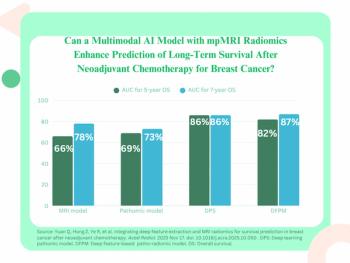
DCIS study stirs questions about greater use of MRI in general screening
Breast MRI is far superior to x-ray mammography for picking up ductal carcinoma in situ generally, and for spotting high-grade early-stage disease in particular, according to a prospective observational study published Aug. 11 in The Lancet.
Breast MRI is far superior to x-ray mammography for picking up ductal carcinoma in situ generally, and for spotting high-grade early-stage disease in particular, according to a prospective observational study published Aug. 11 in The Lancet.The study, by Dr. Christiane Kuhl and colleagues at the University of Bonn in Germany, involved more than 7300 women who underwent diagnostic mammography and MRI read by highly qualified radiologists in a screening setting (Lancet 2007;370:485-492). Mammograms were independently double-read, and MRIs were assessed without mammograms.Of these women, 167 received both imaging tests preoperatively and had a biopsy-proven diagnosis of DCIS without associated invasive breast cancer. Mammography detected 56% and MRI detected 92% of all DCIS. Of the 89 high-grade lesions, MRI detected 98% compared with 52% for mammography. DCIS accounts for about 20% of breast cancers detected in the U.S. This percentage is disappointing, given that most tumors probably evolve from DCIS, according to an accompanying editorial published in the same issue of The Lancet.In an editorial also published in the Aug. 11 issue, Dr. Carla Boetes and colleagues at the Radboud University Nijmegen Medical Centre in the Netherlands argued that the new study findings lead to the inescapable conclusion that MRI outperforms mammography in tumor detection and diagnosis."MRI should thus no longer be regarded as an adjunct to mammography but as a distinct method to detect breast cancer in its earliest stage. A large-scale multicentre breast-screening trial with MRI in the general population is essential," they wrote.In publishing their results, Kuhl and colleagues noted that the sensitivity of screen-film mammography and digital mammography for diagnosing DCIS is limited. Mammography is more likely to pick up more benign, slow-growing types of DCIS, whereas MRI, which is better at assessing tumor vascularization, is more likely to detect cancers with potential to kill the patient if left undetected. MRI also is able to detect cancers prior to calcification.
The 167 women with DCIS were characterized as the following:
- abnormal mammogram: 56%
- normal mammogram: 44%
- average risk: 17%
- MRI for follow-up after breast cancer: 11%
- incidental finding at MRI: 8%
- MRI for screening women at increased familial risk: 5%
- normal mammogram but clinical symptoms: 3%
Patient characteristics such as age, breast density, and family history of breast cancer did not explain the performance differences between two modalities.
"We could not identify factors that would predict the likelihood with which mammographic diagnosis fails. This finding suggests that DCIS could be missed by mammography -- not only in women with dense breast tissue or in women who are at increased risk for breast cancer, but also in women with nondense breasts and in women at average risk," the researchers said.The study's authors advise caution about applying the results generally. Quality standards have not yet been established in breast MRI. The results are not representative of screening in the mass setting, and results are not reproducible."Few radiologists can offer the level of expertise for MRI that comes close to that required for diagnostic mammography," they said. Randomized controlled trials are needed to establish the role of MRI for diagnosing DCIS, including analyses of effects on recurrence and mortality rates, according to the study.For more information from the Diagnostic Imaging archives:
Breast MRI outperforms mammography and US in high-risk women
Clinical support grows steadily for breast MRI
Breast MRI shows promise for population at high risk
Breast MRI wins allies while CAD survives attack
Breast MRI pays its way in preoperative planning
Newsletter
Stay at the forefront of radiology with the Diagnostic Imaging newsletter, delivering the latest news, clinical insights, and imaging advancements for today’s radiologists.




























